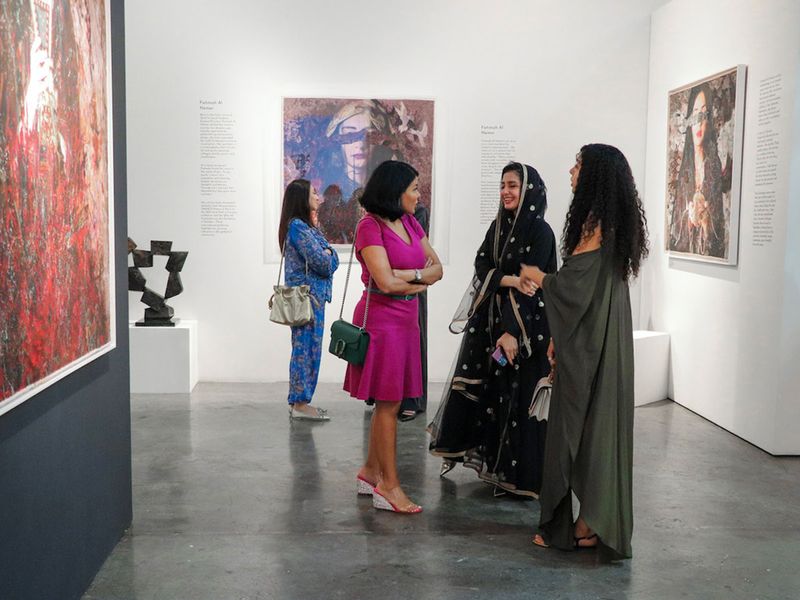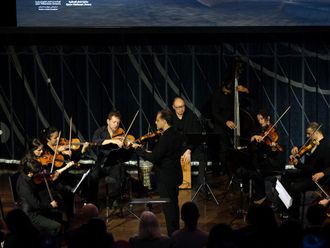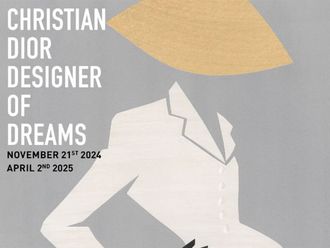
Mestaria Gallery in Dubai’s Alserkal Avenue is hosting “Dkhoun”, an exhibition celebrating the resilience and self-expression of women in the Midde East by Saudi artist Fatimah Al Nemer. We caught up with the artist to find out more about what drove her nine-year long journey culminating in this documentary project.
1. Can you tell us what inspired you to persist with this project for such a long time?
"Dkhoun” Exhibition is a documentary project about individuals from the Arabian Peninsula, and it was the culmination of my research journey. The idea for this project took nine years of research and archiving the stories of real-life personalities, along with holding numerous meetings with inspiring women who had an impact on my life and my homeland. I relied on some of the stories found in the archives of Arabian heritage books. As an artist, I embarked on a research journey through the worlds of these women. It was through them that I discovered myself, exploring their lives until I uncovered the essence and captured the stories that history and tradition have preserved. I then took these stories into my own world, filled with narratives, immersing myself in a realm that became a part of my exhibition.
I traveled with their stories around the world to introduce the world to personalities from my culture, with their diverse origins and the richness of my homeland. "Dkhoun” began in Bahrain in 2019 and later traveled to London, Egypt, Sweden, Riyadh, and, most recently, Dubai in my 11th personal exhibition.
2. Why did you chosen the title “Dkhoun” for your exhibition?
The word "Dkhoun" literally translates to "the finest types of incense." I chose this title for my exhibition because it holds a symbolic meaning beyond its literal translation. While it originally refers to the most precious types of incense, in this artwork, it symbolizes elevated values and emotions we experience, such as goodness, purity, and serenity. When we breathe in a specific scent, we instinctively close our eyes to immerse ourselves in the emotions we feel. For that the name of this exhibition was chosen to transcend beyond the senses, embodying the intuition and nobility of a woman, much like the most exquisite types of incense.

The paintings also carry other symbolic meanings. The pomegranate represents the warmth and beauty of a woman, while the flower symbolizes life. The "Rababa," a traditional stringed musical instrument, is used in one of the artworks to symbolize the transitional journey in a person's life, passing through sadness and personality changes. The dove represents inner peace during life's journey, this was personified in the painting as ‘Shalwa’. While the incense is used to symbolize the strength and wisdom, of Fatima - The princess of the North - the one with a powerful yet delicate sword.
3. Can you tell us about your experience working with tapestry pieces and why you enjoy this artisanal craft?
I focused on creating unique textiles and combining different fabrics from our heritage to the present. The aim was to highlight the beauty, strength, and intelligence of the individuals while seeking to shed light on the authenticity of the region. Each piece tells the story of an extraordinary woman, creating a window for viewers to live the journey of the individual from silence to self-discovery and inner peace, expressing their true selves.

The exhibition consists of eight carefully crafted pieces, each intricately woven using different silk materials and layered on the fabric. Acrylic colors are then added, creating a symphony of color and texture, filling depth and richness into Saudi Arabian culture. I searched into various periods in Arabian history, with one of the most significant stories being that of Princess Noora bint Abdulrahman and her role in the life of the founder, King Abdulaziz. I also explored the character of Shalwa, a foster mother who cared for orphans until they became independent and saved their tribe. Additionally, I told the stories of Salma, a rababa player, Ward Al-Jalaih, and Princess Fatima of the North. I celebrated women as central characters in my artistic narrative, often immersing myself in the heart of these works, embodying the essence of historical stories and inspiring folklore figures.
4. You said you were shy and timid when you were a young girl - how has art helped shape you as an adult?
Through art, I overcame the problem of social anxiety and interactions. As a shy child who was afraid of being involved with a society where voices could be overpowering, art became my voice on the blank canvas. It allowed me to express my thoughts and personality in my childhood. I consider art a way of life and a voice through which I speak without hesitation. It boosted my self-confidence and helped me overcome the fear of facing people. Art was my biggest supporter. In my opinion, I used to draw my thoughts and words that I couldn't say, especially as a child. Expressing myself on paper made them respect me, as being an artist and unique in my class made art a way of life for me, through which I communicated with the world.
5. As a Saudi female artist, what is your personal experience with empowerment and how has society changed in your lifetime for women?
The Kingdom of Saudi Arabia has undergone significant changes and has become a major supporter of women, opening the doors to support and empower women both globally and regionally in the field of art. It had shown the enrichment of its culture and its values through the artistic expressions of women.
In Saudi Arabia, all fields have been opened to women, making Saudi women a cultural and creative force. Art has played a vital role in the evolving Kingdom of Saudi Arabia. The country has witnessed astonishing developments in the field of art in recent years, striving to bring positive changes in society and engage with the outside world through artistic expression. Art became a keystone for the Vision 2030 plan, creating a bridge with the world, and opening up opportunities for Saudi artists… Art is no longer just a topic or an idea of beauty; it has become an integral part of modern Saudi Arabia and Riyadh. The Kingdom has become a global hub for the arts.
6. What do you hope for visitors to take away from experiencing your exhibition?
Each of us has a story worth telling. What is your story? I'm here to introduce visitors to the greatness of Arabian Peninsula's history and the strength of women with their determination and values. I aim to document the national history with the stories of remarkable women who strived and contributed to what we now see as a culture and firm values that we take pride in here in Saudi Arabia.






